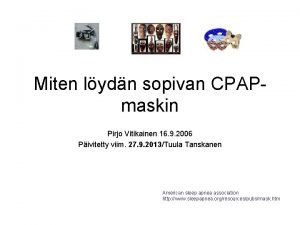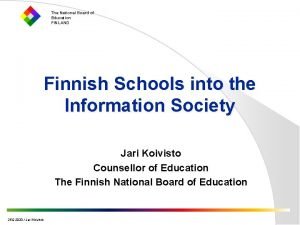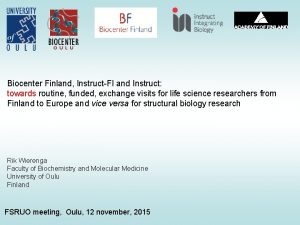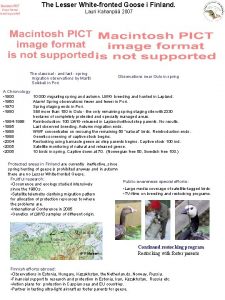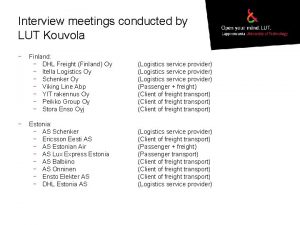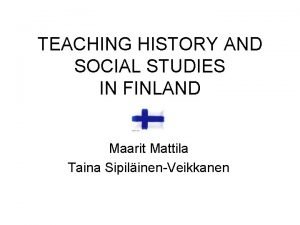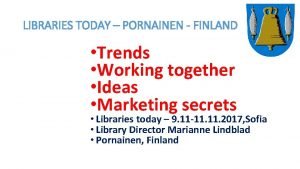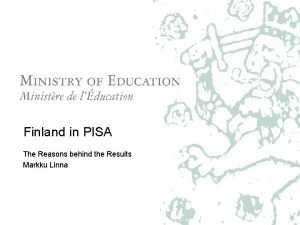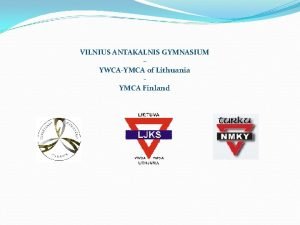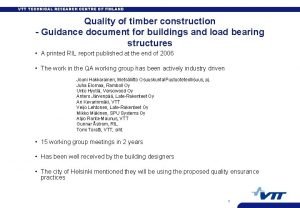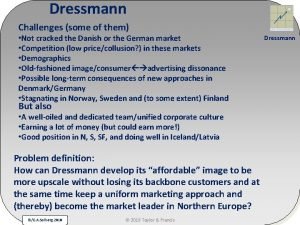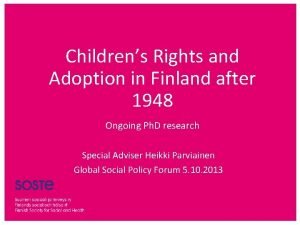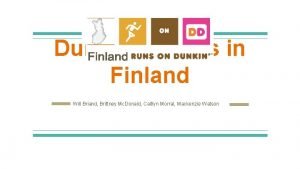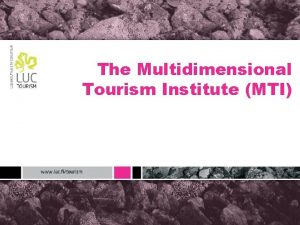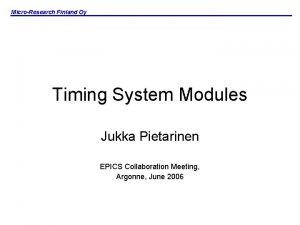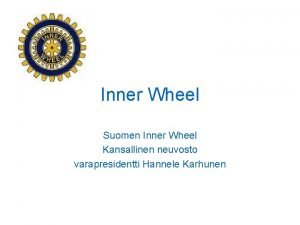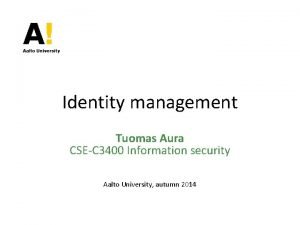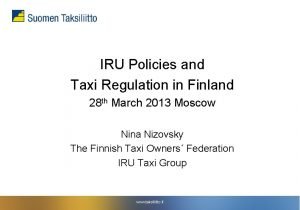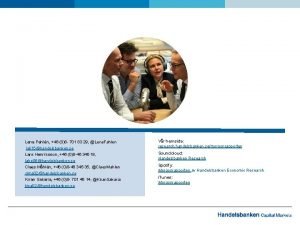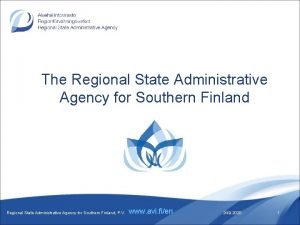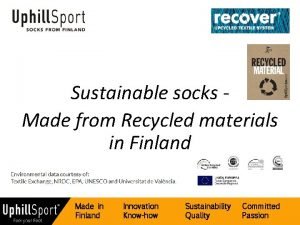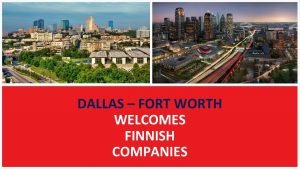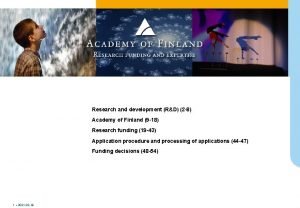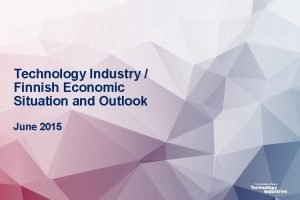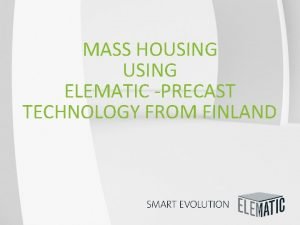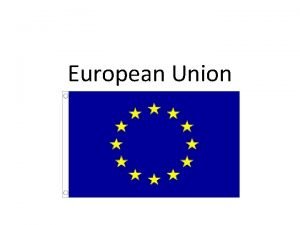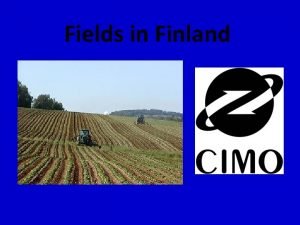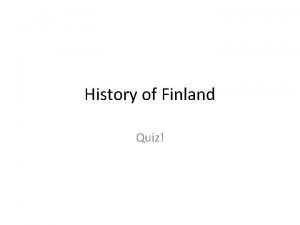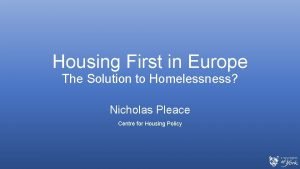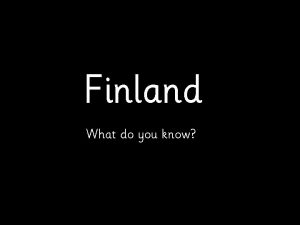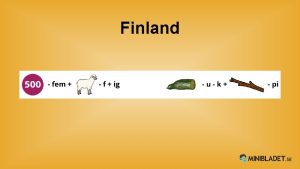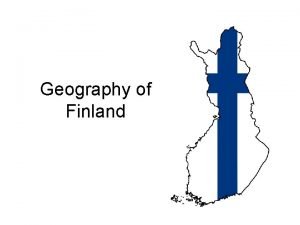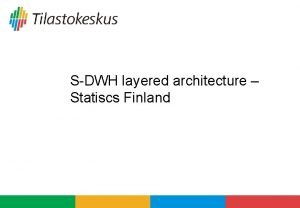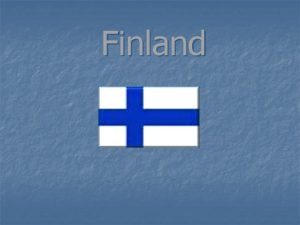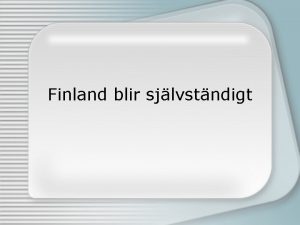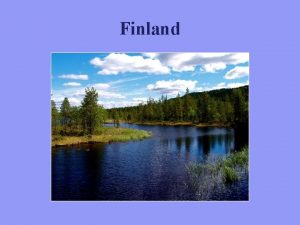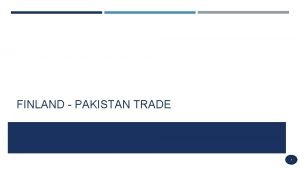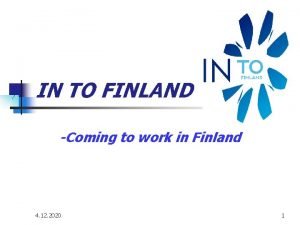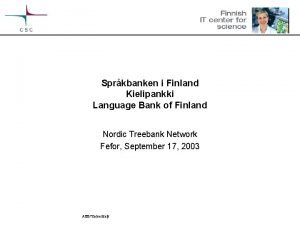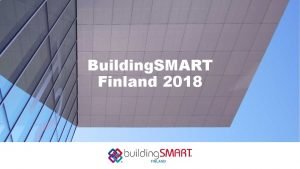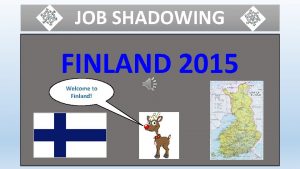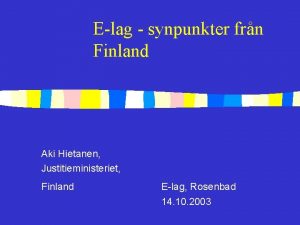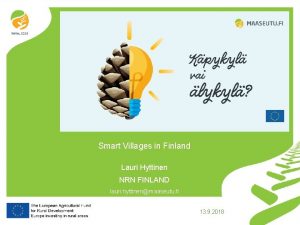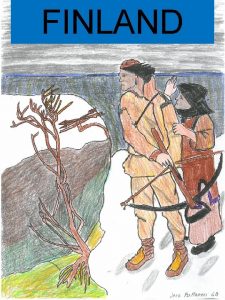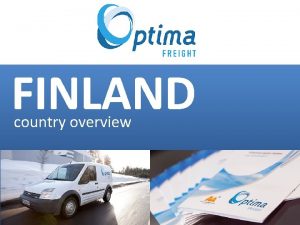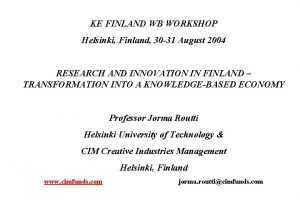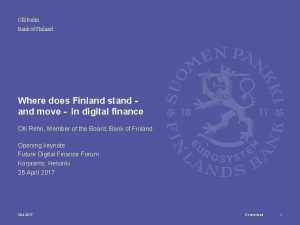1 ACADEMY OF FINLAND 2 ACADEMY OF FINLAND









































- Slides: 41

1 © ACADEMY OF FINLAND

2 © ACADEMY OF FINLAND

www. 3 © ACADEMY OF FINLAND . fi

4 © ACADEMY OF FINLAND

Keynote: Joe Ravetz • • 5 © ACADEMY OF FINLAND Co-Director of the Centre for Urban Resilience & Energy, University of Manchester Strategic thinking for sustainable cities and regions, bringing together • environment-climate policy, • urban planning and design, • new economics and governance, • innovation and futures studies, • systems thinking and complexity science. architect, planner and development manager, creative graphic facilitator and foresight trainer. ‘City-Region 2020: integrated planning for a sustainable environment’ ‘Environment and City’ forthcoming ‘Urban 3. 0’ (Earthscan / Routledge).

Be. MIn. E consortium project Project presentation 6 © ACADEMY OF FINLAND 31. 8. 2016 Raine Mäntysalo

7 © ACADEMY OF FINLAND

Hypothesis The current MALPE work has several problems that hinder it from gaining strategic and integrative foresight in steering Finnish city-regional development towards a more sustainable future. This is due to: • the lack of knowledge on the urbanization dynamics, • lack of concepts and models of urban phenomena, and • failures in dealing with crucial institutional path dependencies and institutional ambiguity. 8 © ACADEMY OF FINLAND

Aims Be. MIn. E aims to bridge these gaps: 1. by producing knowledge on the dynamic interconnections between agglomeration, migration and mobility, and innovation activity processes, and peri-urbanization and fragmentation processes of Finnish urbanization; 2. by re-conceptualizing and –modelling urban phenomena and development, in order to support city-regional planning and decisionmaking; 3. by providing insights and policy recommendations on the restructuring of governance relations and rationalities in terms of integrative envisioning in urban regions, in view of the ongoing Finnish local and regional governance reform and related challenges; and 4. by providing related insights on how to unravel the institutional ambiguities of MALPE governance and manage their consequences to political legitimacy. 9 © ACADEMY OF FINLAND

Phase 1: Path dependence analysis Nov. 30, 2016 10 © ACADEMY OF FINLAND

Path dependencies related to MALPE work • • Urban structure development ‘lock-ins’ (SYKE). Path dependence as car dependence (SYKE & Aalto/BE). ‘Lock-ins’ in urban agglomeration (Jy. U). ‘Lock-ins in regional economic development (VTT). ‘Lock-ins’ in conceptual understandings in planning and analysis (Aalto/Arch. ). Institutional and administrative ‘lock-ins’ in urban and regional governance (UTa & Aalto/BE). Political ‘lock-ins’ in urban and regional governance (UTa). 11 © ACADEMY OF FINLAND

State of the Art report • Path dependence overview as a storyline of historical development paths and future projections – calling for path-breaking openings towards strategic integration in MALPE work (Phase 2). • Hypothesis: Current path dependencies straining MALPE work maintain: • Dispersion of urban structures (with weakening sustainability and accessibility). • Inability to identify and tackle qualitatively new phenomena in urban development (obsolete planning concepts) • Lack of policy coordination (sub-optimization between governance levels and sectors). • Incremental approaches to policy change (policy tinkering). • Poor legitimacy of governance (institutional ambiguity). 12 © ACADEMY OF FINLAND

BEMINE hypotheses – partner presentations 13 © ACADEMY OF FINLAND Mika Ristimäki, SYKE Juha Honkatukia, VTT Hannu Tervo, Jy. U Kimmo Lapintie, AALTO Vesa Kanninen, AALTO Jarmo Vakkuri, UTa Jouni Häkli, UTa

Ari Nissinen (PI) Ville Helminen Antti Rehunen Maija Tiitu Marja Salo Trajectories and policy instruments of urbanisation and regional development - from the state of art to new solutions Finnish environment institute (SYKE) BEMINE kick-off Matti Lindholm Leo Kosonen (’emeritus expert’) Maria Kari Oinonen Kopsakangas 14 © ACADEMY OF FINLAND Savolainen 31. 8. 2016 Mika Ristimäki Maija Mattinen Emma Terämä

Helsinki + 6 200 Urban form and spatial structure: policy instruments from the state Spatial typologies, to identify urbanisation of art to Urban phenomena, path dependences new solutions mechanisms, impacts International comparisons solutions, implementations Planning and policy instruments new + comprehensive Impact assessment. . . Wind power Electricity - housing and agriculture Electricity - services and construction Electricity - industry . . . Fossil fuels - district heating Fossil fuels - other . . . Road transport . . . -1 15 © ACADEMY OF FINLAND 1 3 5 7 Emissions t. CO 2 eq/a/capita 9 Agriculture Airport + 2 900 + 2 000 + 2 700 + 7 500 Growth mostly in office park locations Stockholm + 6 700 + 7 000 Solna Stockholm + 2 300 Central pedestrian Fringe of zone Subcenter pedestrian zone Growth mostly in strongest subcenters

Evidence based planning: potential for regeneration Models for Finnish urbanisation – scenarios Urban fabrics and peri-urbanisation • Recognise: nature-based, people based, community based • Respect: economic potential / policy instruments • Repair, regenerate Generate alternative pathways based on current situation, path dependencies, potentials, resources, sustainability aspects, and Finnish specialities. What is ”affordable” and what kind of Policy instruments are needed in urban and peri-urban areas? 16 © ACADEMY OF FINLAND

Regional economies: methodology and some starting points Be. Mine Kick-Off 17 © ACADEMY OF FINLAND 1. 9. 2016 Juha Honkatukia

AGE models in scenario work • • • One of the most wide-spread economic methods for ex-ante analyses • Wide use in the European Commission, UN, World Bank, various central banks, etc. Based on: • Economic theories on consumers’ and firms’ behavior and long run balance in the economy • Large databases on economic structures, i. e. input-output tables extended with other structural data Account for direct and indirect impacts of economic changes Create consistent scenarios for future based on explicit assumptions and data on exogenous drivers Here focus on economic and policy-related drivers of migration 18 © ACADEMY OF FINLAND

Economics of growth Supply side: Potential GDP is determined by tehcnological change and the productivity growth enabled by it; investment; and the growth of the labout supply (not an issue in most of Europe) • Differences in technology and productivity growth between industries change the structure of the economy • Historically, manufacturing inudstry has out-paced services which has decreased its value-added share • Increasingly, many services are starting to out-pace the rest of the economy Demand: differences in productivity growth affect relative prices and change the structure of demand • Growth in wealth also affects the structure of demand • Demography affect the demand for esp. care services 19 © ACADEMY OF FINLAND

VTT sub-project stage • • • State-of-the-art on-going • regional population growth partly driven by economy-induced migration • What role housing and regional policies? Baselines for national and regional economies updated Regional population forecasts updated • 0 -scenario – regional population without migration trends • Stat. Fin scenario – trend-based migration affects regional pop’s • Policy-scenarios: introduce economic drivers for migration Two broad approaches for migration • Labour-demand driven migration (education, public sector actions etc. ) • Probabilistic migration module Public service scenario updates on-going Linking to transport and housing scenarios commencing 20 © ACADEMY OF FINLAND

Be. MIn. E Jyväskylä University School of Business and Economics Urbanisation & mobility 21 © ACADEMY OF FINLAND 31. 8. 2016 Hannu Tervo Timo Tohmo Mika Haapanen Esa Storhammar Jutta Viinikainen Olle Westerlund (Umeå University

Overview: JSBE research in Be. MIn. E Earlier work Regional and labor economics, particularly questions related to spatial labor market analysis, labor migration, self-employment and regional development Micro-econometric methods and large register-based data sets 22 © ACADEMY OF FINLAND Long-term regional and urban development Assessment of Finnish regional and urban policies Innovation activity as a key element in urban development Entrepreneurial and regional growth activity Role of mobility in equilibrating the regional system of labor markets Be. MIn. E (1) Urban growth processes, entrepreneurship and innovation activity (2) The nature of mobility and its consequences in urban and other regions large register-based micro-econometric data sets methods regional level innovation survey data on firms

(1) Urbanization growth processes: sub-projects • • • Urbanization and surrounding regions • to analyze econometrically the relationship between the development of cities and their hinterlands in different periods in Finland, the main focus being in the most recent decades Urbanization and employment-population relationship • to analyze the nature of mobility and the primary causes of regional growth and urbanization process, by concentrating on the question of whether people follow jobs or jobs follow people Innovation activity and urban growth • to determine whethere are regional differences in innovation activities of small and medium sized enterprises (SME’s) in urban and other areas Dynamic capabilities of Finnish urban enterprises. • to find the factors that reflect dynamic capabilities of Finnish urban enterprises Other: entrepreneurship & urban areas; role of subsidies on urban development 23 © ACADEMY OF FINLAND

(2) Nature of mobility and its consequences in urban regions • • • Migration in urban areas • Micro-econometric analyses of mobility within urban regions as well as between rural and urban regions in Finland, special attention being devoted to the analysis of mobility of students and the highly educated Triple Helix and urban areas • The aim is to analyze the relationships between universities, industries and government under the concept of Triple Helix • Main questions: What are the characteristics of workers moving from universities to government jobs or to private sector jobs? What adds to the appeal and competiveness of cities? Data sources • We have a remote access to Statistics Finland individual-level population databases which can be merged with many administrative registers • This possibility - to combine and use large databases - is crucial for scientific breakthroughs in the analysis of job and human mobility • In addition: firm-level survey data; regional level data 24 © ACADEMY OF FINLAND

Be. MIn. E TOWARDS INFORMED PLANNING PRACTICE Aalto/ARTS/Architecture 31. 8. 2016 Professor Kimmo Lapintie (PI) Post-doctoral Researcher Mina di Marino Doctoral Candidate Hossam Hewidy 25 © ACADEMY OF FINLAND Kimmo Lapintie

From Trajectories to Challenges • The awareness of environmental problems has become mainstream, but urban planning and urban policies still have problems in dealing with them • • • The growth of immigration challenges planning and design for “all”. • • • The ecosystem services (regulating, provisioning, supporting and cultural) are potentially endangered in the context of urban growth and density Urban concentration and sprawl makes it difficult to organize services for the ageing population In planning and urban policies there is an implicit references to a uniform culture and bio-politics (planning based on biological features such as age, gender and disability, ignoring cultural differences) Since this is no longer reality, planning has to build a relationship to multi-culturalism. Planning directed at, and contained within, specified geographical areas, is challenged by multi-locality of employment and housing • • The increasing role of ICT in working practices has made working possible in several locations. Social connections and the related space-related life-styles are forming networks, at the same time as urban and regional planning and policies concentrate on areas. 26 © ACADEMY OF FINLAND

Using knowledge in urban planning and policies • Urban and regional planning and urban development is by its nature interdisciplinary • • Some knowledge is produced outside their main domains (such as in ecology, sociology, economics, political science and philosophy) Some knowledge is created through its own practice, where knowledge often has a tacit dimension (such as in design, communicative skills, creativity, visioning, meaning-creation). There is no straightforward path from explicit knowledge to practice The inevitable connectedness of knowledge and power (power/knowledge) • • Professionalism, political regimes and discourse coalitions have to be taken into account. Theoretically, thus, it is necessary to understand this relationship between episteme and praxis, which often prevents dialogue between experts and stakeholders. 27 © ACADEMY OF FINLAND

Research questions • 1. What kind of discourse formations has been formed and is forming with respect to these challenges, with all of their "discontinuity, break, threshold, or limit” (Foucault 1969)? • • What kind of input could research bring to planning practice in order to help planners and policy makers to deal with these new challenges (strategies, representations, arguments, and theoretical input that has not yet found its way to the planning discourses)? • 28 © ACADEMY OF FINLAND The empirical material used consists of documents and interviews, but also the workshops etc. that are organised in the main project. This is done by actively developing textual and visual representations to accommodate the mentioned need for new discursive formations.

From disjointed M A L P E towards trading zones of strategic city-regional development Aalto University, Department of the Built Environment Raine Mäntysalo professor, strategic spatial planning Milos Mladenovic ass. professor, transport technology Vesa Kanninen researcher Aino Hirvola researcher Kaisa Granqvist research assistant Aalto BE research approach 29 © ACADEMY OF FINLAND 31. 08. 2016 Vesa Kanninen

From disjointed M A L P E towards trading zones of strategic city-regional development • • • MALPE –an emerging yet contested/contestable approach to integrated planning A conventional bricolage: bringing sectors together and hoping for the best? MALPE in Finnish urban regions: slow development over 15 years • Successes: creating common visions, strategies, programmes • Failures: clashing interests hindering collaboration, municipal competition over cooperation; clash of governance rationalities and institutional boundaries between different sectors • MAL(PE) agreements: neoliberal spatial policy frameworks • efficient for creating interaction, forcing collaboration, directing investments, but • lacking in overall coordination with other policies, ambiguous status vs. the planning system, issues with leadership, ownership, legitimacy? Need for an integrated approach for addressing the above issues The Aalto/BE Be. MIn. E approach: finding, creating and fostering ”trading zone” – alignments and collaboration 30 © ACADEMY OF FINLAND

Trading Zones in planning Planning cultures Legislation, guidance, policies Informal visions Contact Zones: institutional, organisational and resource frameworks for politicizing issues, revealing power relations, creating dialogue, debate, strife Planning processes Trading Zones: intentional simplification and focus through mutual thin descriptions, partial agreements, co-creation and co-design Planning episodes Source: Kanninen, V. (forthcoming, 2017) The emergence of the strategic city-region: towards agonistic articulations of power, process and planning in trading zones of spatial development. 31 © ACADEMY OF FINLAND Regional planning Mutual master plans MAL agreements Development programmes Structural schemes Growth agreements Mutual investment programmes Strategic projects Detail plans

Research and Co-Creation themes • • Current MALPE work and existing densification policies • Institutional lock-ins and ambiguities in governance rationalities and policy coordination Reconceptualization of city-regional governance • interlinking municipal economy –based and spatial governance –based rationalities in local and regional governance reform • reconfiguring state-local level governance relations ‘Hard’ and ‘soft’ MALPE governance and political agency formation • co-aligning to support strategy-making and legitimacy Mobilizing the new understanding of urbanization dynamics • assessment of transformative capacities, challenges and obstacles • assessment of new decision support tools and governance insights 32 © ACADEMY OF FINLAND

Ambiguities of decisionmaking and performance metrics in urban policymaking The research group: Professor Eija Vinnari Research director Harri Laihonen University lecturer Lotta-Maria Sinervo University lecturer Ilari Karppi Professor Jarmo Vakkuri 33 © ACADEMY OF FINLAND 31 August, 2016 Professor Jarmo Vakkuri University of Tampere, School of Management jarmo. vakkuri@uta. fi

Framing the problem Two types of limitations and ambiguities in decision-making and knowledge production of urban policy-making 1. Decision-making in the context of Finnish urban policies/MALPE: how to… • balance between scarce financial resources, development of public service delivery systems and socio-ecologically viable urban planning? • understand different time spans of decision-making cycles? • avoid sub-optimization and maintain coordinated division of labor? 2. Limitations in the design and use of management instruments and performance evaluation for urban policy-making: how to develop… • performance evaluation and measurement systems for urban planning? • other forms of knowledge production for sustainable urban policies? 34 © ACADEMY OF FINLAND

Research contexts of our work package 1. Ambiguities of the performance evaluation information • Performance measurement systems and practices in selected city regions • Problems of multi-dimensional performance evaluations to encompass financial sustainability, effective land-use and ecological sustainability. 2. Complexities that stem from planning and management artefacts • Blackboxing, governance silos and sub-optimization • Artefacts linking land-use, public service delivery systems and sustainable local government finances (e. g. “PALM” in Tampere). 3. Planning/management artefacts as drivers of urban policy-making • The role of new technologies in featuring the ideas of good and sustainable urban environment • How do the ideas of good/sustainable urban environment shape decisionmakers’ interpretive schemes and mental models? Conclusive synthesis 35 © ACADEMY OF FINLAND

The research group • • • Two professors, three postdoctoral researchers and one post-graduate student. Extending the previous work by the group in exploring distinct forms of economic rationalism in different contexts of the modern public sector (e. g. Vinnari & Näsi 2008; Sinervo 2011; Vakkuri 2010; van Helden et al. 2012). Emphasizing/new emerging modes of economic activities in hybrid forms of governance; Vakkuri and Karppi being involved in JULMA research project funded by Prime Minister’s Office of Finland (VNK) Scientific collaborators include: • Prof. Robert Beauregard, Columbia University, one of the leading scholars in research of the material basis and the use of artefacts and “things” in urban planning. His major contribution is in the contexts 2 and 3. • Prof. Giuseppe Grossi, Kristianstad University, has done extensive work on performance measurement and management in the public sector, and in hybrid organizations and systems. His major contribution is in the contexts 1 and 2. Practitioners: top managers of the case city regions. 36 © ACADEMY OF FINLAND

The citizens’ voice in MALPE work? SPARG/RELATE Co. E Research team, University of Tampere, School of Management Team leader Prof. Jouni Häkli Responsible researcher Dr. Pia Bäcklund Dr. , docent Kirsi Pauliina Kallio Researcher Olli Ruokolainen 37 © ACADEMY OF FINLAND

Starting points for research and co-creation in MALPE work: • • The strategic MALPE planning brings together various actors (public, private, third sector), builds new territorial settings (most importantly city regions as conglomerations of several municipalities), and co-exists with statutory (formal) planning à Ambiguities between classical-modernist government and network governance planning logics Questions of accountability, transparency and publicity: “new practices are short circuiting some of the formal democratic processes of statutory planning” (Allmendinger and Haughton, 2010: 813) à citizen participation? Main research questions: 1) How does the (emerging) MALPE work relate to participation (that is in flux)? 2) Can MALPE practices better utilize participatory energies to promote democracy and sustainability in city regions? 38 © ACADEMY OF FINLAND

Participation, zoning and MALPE work Citizen participation Land Use and Building Act (1999/132) ? Formal land use planning Interface between strategic and statutory planning 39 © ACADEMY OF FINLAND Strategic MALPE ’governance’

Hypothesis, key concept and research aims and tasks: • • Hypothesis: MALPE has limited possibilities to statutory forms of participation, but may be more open to ’inputs’ from lived citizenship Lived citizenship: various forms of everyday political agency that are motivated by issues (rarther than territorial domicile) and build knowledge concerning weak signals of urban dynamics Aims and tasks: To enhance the knowledge base of MALPE activities, by: 1) exploring existing views on what is the place of citizen participation in MALPE work (what, when, how and by whom) – path dependence analysis 2) co-creating participatory practices that are both sensitive to different forms of lived citizenship and resonate with MALPE issues Data: • Policy documents on the publicity of MALPE work and participation practices • Key actors’ interviews concerning participation • Survey for citizens in case study areas on how familiar they are with MALPE work 40 © ACADEMY OF FINLAND

41 © ACADEMY OF FINLAND
 Resmed finland oy
Resmed finland oy Finland oats
Finland oats Finnish national board of education
Finnish national board of education Pespallo
Pespallo The modern mother's day celebration originated from
The modern mother's day celebration originated from Technology industries of finland
Technology industries of finland Biocenter finland
Biocenter finland Goose creek finland
Goose creek finland Dhl joensuu
Dhl joensuu Maarit haikonen
Maarit haikonen Pornainen finland
Pornainen finland Bookit
Bookit Pisa
Pisa Local guide program
Local guide program Technical
Technical Dressmann finland
Dressmann finland Adoption in finland
Adoption in finland Education export finland
Education export finland Dunkin donuts helsinki
Dunkin donuts helsinki Mti map
Mti map Micro research finland
Micro research finland Finland facts and information
Finland facts and information Inner wheel finland
Inner wheel finland Finland ti
Finland ti Tuomas aura
Tuomas aura Taxi license finland
Taxi license finland Logaritmisk avkastning
Logaritmisk avkastning Work life balance finland
Work life balance finland Regional state administrative agency for southern finland
Regional state administrative agency for southern finland Recycled material socks
Recycled material socks Population distribution
Population distribution Finland education budget 2021
Finland education budget 2021 Technology industries of finland
Technology industries of finland Esa sundbäck
Esa sundbäck Kldi
Kldi Elematic group
Elematic group Hungary capital
Hungary capital Fdi in finland
Fdi in finland Finland fields
Finland fields Fiskars fashion
Fiskars fashion Finland quiz
Finland quiz Finland homelessness solution
Finland homelessness solution
